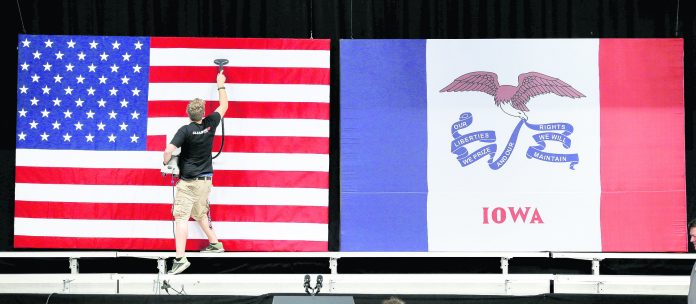
Few states have changed politically with the head-snapping speed of Iowa. The question heading into 2020 is whether it’s going to change again.
In 2008, Iowans voters propelled Barack Obama toward the White House. A year later, the state’s Supreme Court sanctioned same-sex marriage. In 2012, Iowa backed Obama again.
By 2016, Donald Trump easily defeated Hillary Clinton in Iowa. Republicans were in control of the governor’s mansion and state legislature and held all but one U.S. House seat. For the first time since 1980, both U.S. Senate seats were in GOP hands.
Voters were slow to embrace Obama’s signature health care law. The recession depleted college educated voters as a share of the rural population, and Republicans successfully painted Democrats’ as the party of coastal elites.
Trump carried Iowa by a larger percentage of the vote than in Texas, and carried counties no Republican since Dwight D. Eisenhower had won.
But now, as Democrats turn their focus Iowa’s kickoff caucuses to begin the process of selecting Trump’s challenger, could the state be showing signs of swinging back?
If Iowa’s rightward swing has stalled, it could be a foreboding sign for Trump in other upper Midwestern states he carried by much smaller margins and would need to win again.
“This is an actual correction,” Tom Vilsack, the only two-term Democratic governor in the past 50 years, said of Republicans.
Iowans unseated two Republican U.S. House members in 2018 during midterm elections where more Iowa voters in the aggregate chose a Democrat for federal office for the first time in a decade.
“I think that leaves little question Iowa is up for grabs next year,” veteran Iowa Democratic campaign consultant Jeff Link said.
There’s more going on in Iowa that simply a merely cyclical swing.
Once-GOP-leaning suburbs and exurbs have swelled with college-educated adults in the past decade, giving rise to a new class of rising Democratic leaders.
“I don’t believe it was temporary,” Iowa State University economist David Swenson said of Democrats’ 2018 gains in suburban Des Moines and Cedar Rapids. “I think it is the inexorable outcome of demographic and educational shifts.”
The Democratic caucuses will provide a test of how broad the change may be.
For now, that is not a widely held view, as Iowa has shown signs of losing its swing state status.
In the 1980s, it gave rise to a populist movement in rural areas from the left, the ascent of the religious right as a political force and the start of an enduring rural-urban balance embodied by Republican Sen. Chuck Grassley and Democratic Sen. Tom Harkin.
After 30 years of Republican dominance in Iowa’s governor’s mansion, Vilsack was elected in 1998 as a former small-city mayor and pragmatic state senator.
An era of partisan balance in Iowa took hold, punctuated by narrow Iowa wins by Democrat Al Gore in 2000 and George W. Bush in 2004.
After the 2006 national wave swept Democrats into total Statehouse control, Obama’s combination of generational change, his appeal to anti-Iraq War sentiment and the historic opportunity to elect the first African American president made Iowa an easy win.
“We were like a conquering army, prepared to negotiate terms of surrender,” said Cedar Rapids Democrat Dale Todd, an early Obama supporter and adviser.
Today, in the state Capitol, there are reminders of how much the ground had shifted since those heady days.
Republicans today control all of state government for the first time in 20 years, in line with takeovers in nearby states that were completed earlier but traced their beginnings to the same turbulent summer of 2009.
On a Wednesday in August that year, throngs flocked to Grassley’s typically quiet annual county visits to protest his work with Democrats on health care legislation.
The previous April, Iowa’s Supreme Court unanimously declared same-sex marriage legal. A year later, Christian conservatives successfully campaigned to oust the three Supreme Court justices facing retention.
By 2016, Republicans had completed their long-sought statehouse takeover, in part by triumphantly beating longtime Senate Majority Leader Mike Gronstal.
The answer for Democrats in Iowa is much the same as the rest of the country: growing, vote-rich suburbs.
Dallas County, west of Des Moines, has grown by 121% since 2000. Last year, long-held Republican Iowa House districts in Des Moines’ western suburbs fell to Democrats.
It was the culmination of two decades of shifting educational attainment with political implications.
Since 2000, the number of Iowans with at least a college degree in urban and suburban areas grew by twice the rate of rural areas, according to U.S. Census data and an Iowa State University study.
Since 2016 alone, registered Democrats in Dallas County have increased 15%, to Republicans’ 2%. Republicans still outnumber Democrats, but independent voters have leaped by 20% and now outnumber Republicans.
“There is now a third front,” Gronstal said.
Though Trump’s return to the ballot in 2020 shakes up the calculus, his approval in Iowa has remained around 45% or lower, typically problematic for an incumbent.
Another warning for Trump, GOP operative John Stineman noted, is The Des Moines Register/CNN/Mediacom Iowa Poll’s November finding that only 76% of self-identified Republicans said they would definitely vote to re-elect him next year.
With no challenger and 10 months until the election, a lot can change.
“Still, that’s one in four of your family that’s not locked down,” Stineman said.
Democratic turnout in 2018 leaped from the previous midterm in 2014, according to the Iowa Secretary of State. Republican turnout also rose, but by a smaller margin.
“I think the success in the midterms kind of made people on the Democratic side believe that ‘we can do it,'” said J. Ann Selzer, who has conducted The Des Moines Register’s Iowa Poll for more than 25 years.
Perhaps, but Trump has his believers, too.



















